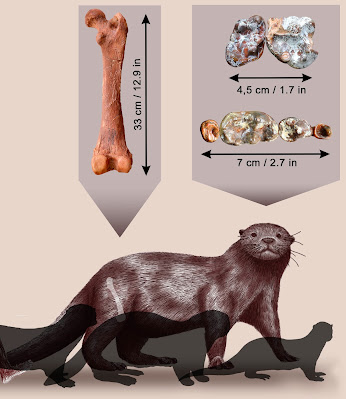We describe otter remains (Lutrinae Bonaparte, 1838) from the Plio-Pleistocene of the Lower Omo Valley of southwestern Ethiopia. We report isolated lower and upper teeth of Torolutra sp. dated to c. 3.3 Ma, dental specimens and a femur of Enhydriodon Falconer, 1868, attributed to a new species, dated between c. 3.4 Ma and 2.5 Ma, as well as a humerus of Lutrinae indet. dated between c. 1.9 Ma and 1.8 Ma. The new species Enhydriodon omoensis n. sp. is the largest species of the genus discovered so far. It is even larger than its close relative E. dikikae Geraads, Alemseged, Bobe & Reed, 2011, a Pliocene lion-sized otter from the Afar region and potentially from eastern Turkana. Based on stable oxygen and carbon isotope analyses, we found that Enhydriodon from the Lower Omo Valley could have been terrestrial and fed on both aquatic and terrestrial prey, acquired by either hunting or scavenging. It filled a unique ecological niche in the past communities co-existing with australopithecines. Enhydriodon and Torolutra Petter, Pickford & Howell, 1991 went extinct in Africa around the Plio-Pleistocene transition, along with many large-sized and ecologically specialized carnivorans. This extinction event could be linked to the many geological, climate, and biotic changes occurring in the eastern African rift during this period, notably the incursion of early hominins into the carnivore guild.
KEYWORDS: Otters, carnivorans, Africa, ecological niche, stable isotopes, new species
Enhydriodon omoensis n. sp.
Etymology. — species name is derived from the lower Omo valley, where it has been recovered.
Camille GROHÉ, Kevin UNO & Jean-Renaud BOISSERIE. 2022. Lutrinae Bonaparte, 1838 (Carnivora, Mustelidae) from the Plio-Pleistocene of the Lower Omo Valley, southwestern Ethiopia: Systematics and New Insights into the Paleoecology and Paleobiogeography of the Turkana otters. COMPTES RENDUS PALEVOL. 21(30); 681-705. DOI: 10.5852/cr-palevol2022v21a30
phys.org/news/2022-09-ethiopia-scientists-fossil-otter-size.html
Lutrinae Bonaparte, 1838 (Carnivora, Mustelidae) du Plio-Pléistocène de la basse vallée de l’Omo, sud-ouest éthiopien : systématique et nouvelles données sur la paléoécologie et la paléobiogéographie des loutres du Turkana
Nous décrivons des restes de loutres (Lutrinae Bonaparte, 1838) du Plio-Pléistocène de la basse vallée de l’Omo, au Sud-Ouest de l’Éthiopie. Nous rapportons des dents inférieures et supérieures isolées de Torolutra sp., datées de c. 3,3 Ma, des specimens dentaires et un femur d’Enhydriodon Falconer, 1868, attribués à une nouvelle espèce, datés entre c. 3,4 et 2,5 Ma, ainsi qu’un humérus de Lutrinae indet., daté entre c. 1,9 et 1,8 Ma. La nouvelle espèce Enhydriodon omoensis n. sp. est la plus grande espèce du genre découverte à ce jour. Elle est encore plus grande que son proche parent E. dikikae Geraads, Alemseged, Bobe & Reed, 2011, une loutre pliocène de la taille d’un lion provenant de la région de l’Afar et potentiellement de l’Est du Turkana. Elle remplissait une niche écologique singulière dans les communautés du passé coexistantes avec les australopithécines. À partir des analyses des isotopes stables de l’oxygène et du carbone, nous avons mis en evidence qu’Enhydriodon de la basse vallée de l’Omo devait être terrestre et se nourrir de proies aquatiques et terrestres, acquises par la chasse ou le charognage. Enhydriodon et Torolutra Petter, Pickford & Howell, 1991 se sont éteintes en Afrique aux environs de la transition Plio-Pléistocène, à la même période que de nombreux carnivores de grande taille et spécialisés d’un point de vue écologique. Cet évènement d’extinctions pourrait être lié aux nombreux changements géologiques, climatiques et biotiques associés au rift est-africain durant cette période, notamment à l’incursion des hominines anciens dans la guilde carnivore.
MOTS-CLÉS: Loutres, carnivores, Afrique, niche écologique, isotopes stables, espèce nouvelle



